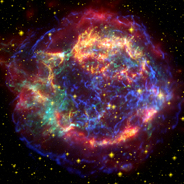Interactive Overview
Slider Interactive: This illustration, which is a minimalist representation that conveys concepts rather than the fine details, is a work-from-home scene during the daytime. On the left side of the room is a fireplace with an active fire kindled. On top of its mantel sits a plant in between a plant grow light on the left and a small radio to the right. A cat is resting in front of the fireplace. On the right side of the fireplace is a WiFi router on a low stool. At the far right of the illustration is a person sitting at a table looking at their laptop while holding a cellphone. A pitcher of ice water and an accompanying glass of water is also on the table. A ceiling light is hanging above the person. The room has a large two-panel window that is mostly open, with a portion of the glass visible toward the top. Through the window’s left panel, is a view into a dentist office with a patient getting an X-ray. Through the window’s right panel is a cluster of trees, a radio tower on the horizon, and a view of the sky.
Below the caption is a horizontal slider bar with six labeled stops and a solid white circle. Dragging the white circle right and left along the slider bar causes the color and brightness of objects in the image to change, along with the caption. The change gradually occurs as the image, along with its associated caption and labels, fades out and the next fades in with different objects in the scene becoming brighter and dimmer. A toggle button at the upper right of the image turns the image labels off and on. The labels are in the form of text with arrows pointing to specific features in the image.
Slider Stops
From left to right, the slider stops are labeled: Radio/Microwave, Infrared, Visible, Ultraviolet, X-ray, and Gamma Ray.
Summary of Slider Stops
Sliding left to right reveals the following:
- “Radio/Microwave” stop shows a silhouette of the scene with six objects in white that are visible in radio/microwave.
- “Infrared” stop shows the scene in shades of gray, with hotter objects shown in brighter (whiter) colors.
- “Visible” stop shows the scene in full color similar to how it is perceived by most people. This is the initial image shown when the interactive is loaded.
- “Ultraviolet” stop shows a silhouette of the scene with three objects in white that are visible in ultraviolet.
- “X-ray” stop shows a silhouette of the scene with three objects in white that are visible in X-ray.
- “Gamma ray” stop shows a silhouette of the scene with two objects in white that are visible in X-ray.
Stop 1: Radio/Microwave
Image Description: Radio/Microwave
The home scene is shown in a single shade of dark gray with select objects highlighted in white. Objects highlighted in white indicate that they emit radio and/or microwave light, including the radio/television tower, Sun, antenna of the WiFi router, laptop, and phone. Additionally, a small white circle representing a pulsar is in the left side of the sky. This object is not visible in any other stop in the interactive. Everything else in the scene is dark gray and visible only by their silhouettes.
Labels: Radio/Microwave
There are three text labels. The small white circle seen in the sky through the left side of the window is labeled, “Pulsar.” The slightly larger circle out the window is labeled, “Radio/TV Tower.” The white vertical line towards the bottom of the scene highlights the antenna of the internet router, which is labeled “WiFi.”
Caption: Radio/Microwave
If your eyes could detect radio waves and microwaves, you could see light carrying information to radios, phones, and computers.
Stop 2: Infrared
Image Description: Infrared
The home scene is the same as in the “Radio/Microwave” stop, with the room’s objects in different shades of gray according to how much infrared light they are emitting: from white (very bright in infrared) to black (very dim in infrared). White objects include the Sun, grow light, fire, and WiFi router. Light gray objects include the cat, radio, laptop, cellphone, and person’s skin. Gray items include the person’s clothes, ceiling light, the mostly open window’s glass that blocks some of the Sun from view, radio tower, trees, and equipment in the dentist’s office. Dark gray items include the desk, chair, and floor. Black items are the ice water in the pitcher and cup.
Labels: Infrared
There are two text labels in the illustration. The pitcher, which has a dark gray silhouette, is labeled “Ice Water.” The cat, which appears light gray, is labeled “Warm Animal.”
Caption: Infrared
The hotter an object is, the brighter it glows in infrared light.
Stop 3: Visible
Image Description: Visible
The home scene is shown in various colors of visible light. The sky outside the window is light blue and the yellow circle is the Sun. The dentist office seen through the window is gray, with a sign that says “Dentist” at the top of the building in white lettering against a dark blue background. The radio/television tower is a darker shade of blue against the sky and stands on green grass. Inside the home, the room’s wall is a light blue and the carpet is blue-green. The fireplace is also blue-green and has white trimming along the mantel’s edges. The grow light and plant pot on top of the fireplace are dark blue, while the radio is blue-green. A yellow and orange-colored fire is inside the fireplace’s hearth. A light brown cat is sleeping on the floor in front of the fire. The stool to the right of the fireplace is white and has a dark blue WiFi router on top. On the other side of the stool is a white table with a full pitcher of ice water, a cup, and a laptop. The person is sitting on an orange chair at the desk while working on their laptop with a cellphone in their hand. A dark blue ceiling light is hanging above the person.
Labels: Visible
There are two text labels. The plant sitting on top of the fireplace mantel is labeled “Plants reflect visible light.” The Sun seen through the window is labeled “The Sun emits visible light.”
Caption: Visible
Human eyes can see things that emit or reflect various colors of visible light.
Stop 4: Ultraviolet
Image Description: Ultraviolet
This image is located just to the right of “Visible,” and shows the home in a single shade of dark gray with select objects highlighted in white. Three objects are highlighted in white to indicate that they emit ultraviolet light: the plant grow light, the Sun with a fuzzy outer edge, and a group of small white dots that represents a star-forming region. The star-forming region is not visible in any other stop in the interactive. Everything else in the scene is dark gray and visible only by their silhouettes.
Labels: Ultraviolet
There are two text labels. The plant light on the fireplace mantel is labeled “Grow light.” The group of small dots seen in the sky out the window is labeled “Star-forming region.”
Caption: Ultraviolet
Ultraviolet light has shorter wavelengths and higher energy than visible light.
Stop 5: X-ray
Image Description: X-ray
This image is located just to the right of “Ultraviolet,” and continues to show the home in a single shade of dark gray with select objects highlighted in white. Three objects seen out the window are white to indicate they emit X-ray light: the dentist office’s X-ray imaging machine, the Sun with a fuzzy outer edge similar to the “Ultraviolet” stop, and a small white circle which represents a supernova—an object that is not visible in any other stop in the interactive. Everything else in the scene is dark gray and visible only by their silhouettes.
Labels: X-ray
There are three text labels. The white ellipse in the lower left of the window view is labeled “X-ray imaging machine.” The small circle in the middle of the window is labeled “Supernova.” The fuzzy outer edge of the larger circle out the window is labeled “Sun’s corona.”
Caption: X-ray
Only extremely hot objects and high-energy events give off X-rays.
Stop 6: Gamma Ray
Image Description: Gamma Ray
This image is located just to the right of the “X-ray” image, and continues to show the home in a single shade of dark gray with select objects highlighted in white. Two sets of objects, both seen in the sky through the window, are highlighted in white to indicate that they emit gamma rays. The circle of the Sun is brighter near the edges and darker toward the center. Four small, solid white circles depicting solar flares dot the surface. On the left is a pair of white dots that represent colliding neutron stars. None of these white dots are visible in any other stop in the interactive. Everything else in the scene is dark gray and visible only by their silhouettes.
Labels: Gamma Ray
There are two text labels. The two small white dots out the window are labeled “Colliding neutron stars.” A larger but faded white circle represents the Sun and is overlaid with four small solid white circles that are labeled “Solar flares.”
Caption: Gamma Ray
Once in a while, an explosion on the Sun or in space is energetic enough to emit gamma rays.









